Are you STRUGGLING to find room for some lovely flowers in your GARDEN? No worries, we’ve got just the THING for you – the Dwarf Hydrangea!
It’s PERFECT for small spaces and will bring a POP of COLOR to any garden.
At AsterGardening, we’re about helping you become a GARDENING PRO. We show you why the Hydrangea is FANTASTIC for your small garden.
We also tell you how to take care of them. Trust us. We’ve got your BACK.
Get EXCITED to be blown away by the BEAUTY of this amazing plant. Don’t let limited space hold you back from enjoying a GORGEOUS garden!

How do you take care of a dwarf hydrangea?

These hydrangea varieties only grow 2-3 feet tall and wide. It makes them PERFECT for small gardens, patios, or flower beds.
They need some TLC to thrive. Here’s what you need to KNOW.
1. Light
First, when planting your Hydrangea, choose a spot in PARTIAL SHADE with soil that drains well.
You don’t want to give it too much sun, or the leaves will WILT. The result? The blooms won’t be as VIBRANT.
2. Water
Now for the WATERING. Small hydrangeas like to be kept MOIST, but don’t drown them!
They need about an inch of water per week, whether from the rain or with a watering can. Ensure to give them only a little, or they could get a ROOT ROT.
3. Fertilizer
Fertilizer time! Use a SLOW-RELEASE fertilizer in the spring and summer. Stay AWAY from ones high in nitrogen, or you’ll end up with more leaves and fewer flowers.
You want to USE one that says it’s GOOD for hydrangea varieties.
4. Pruning
Pruning is important to control your plant’s size and shape and PROMOTE new growth. If you want MORE flowers, cut off the dead ones.
The best time to do this is in LATE winter or EARLY spring.
5. Mulch
Lastly, remember to WINTER CARE! You Don’t WANT your poor plant to FREEZE.
Add a nice layer of mulch around the base. Consider COVERING it with burlap. You can use something else that will PROTECT it from the harsh elements.
So there you HAVE it! Caring for dwarf hydrangea plants isn’t too HARD. It only takes to love hydrangeas and some effort.
12 Types of Dwarf Hydrangea
Ready to check out some AWESOME dwarf hydrangea varieties for your GARDEN? Here are twelve fantastic varieties to choose from!
· Hydrangea Paniculata
1. Little Quick Fire
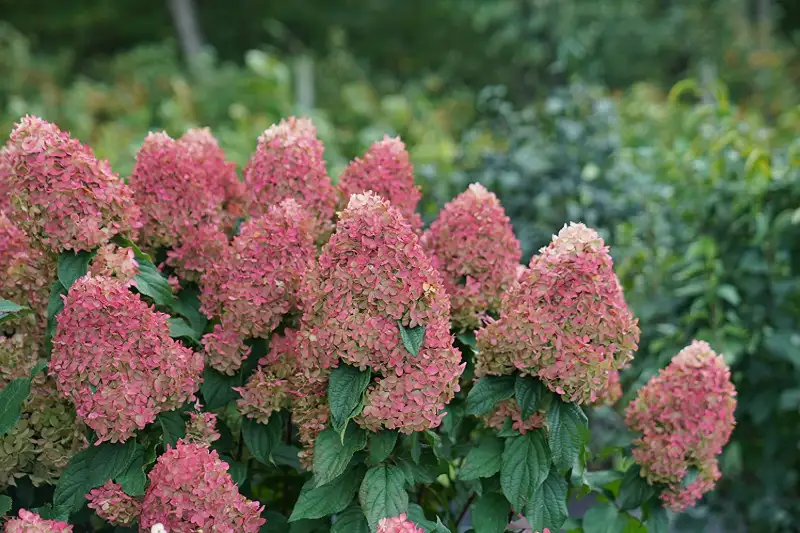
The Little Quick Fire Flower is a gorgeous plant variety of Panicle Hydrangea. It’s ORIGINALLY from Japan and China.
It’s one of the coolest panicle hydrangeas. It changes flower color to pinkish red depending on how much SUNLIGHT it gets.
So neat, right?
The Little Quick Fire Flower BLOOMS early in the summer. Its smaller SIZE makes it AWESOME for planting in smaller yards or CONTAINERS.
Ensure you GIVE this Panicle Hydrangea some shade but also some sun. Keep the soil a bit MOIST and drain well. It can handle CHILLY temps in USDA zones 3-8.
This plant has a SUPER LONG blooming season. It blooms from mid-summer to fall with an average of 3 feet in height. You, Gotta, LOVE it!
2. Bombshell

BOMBSHELL is super cool and dates back to ancient Greece and Rome. Its name MEANS “divine flower” in Greek, so you know it’s LEGIT.
This Hydrangea Paniculata comes in COLORS like white, pink, red, and purple. But what really sets it apart? It’s signature SPICY smells like clove. YUM!
The panicle hydrangeas require PLENTY of sunshine and well-drained soil. I have GROWN them on some of the acidic soil, with a pH of around 6.0 to 6.5. It works like a charm!
They BLOOM from late spring to summer, so you’ve got PLENTY of time before leaves fall. My RECOMMENDATION is to grow them in USDA zones 7-10.
3. Bobo
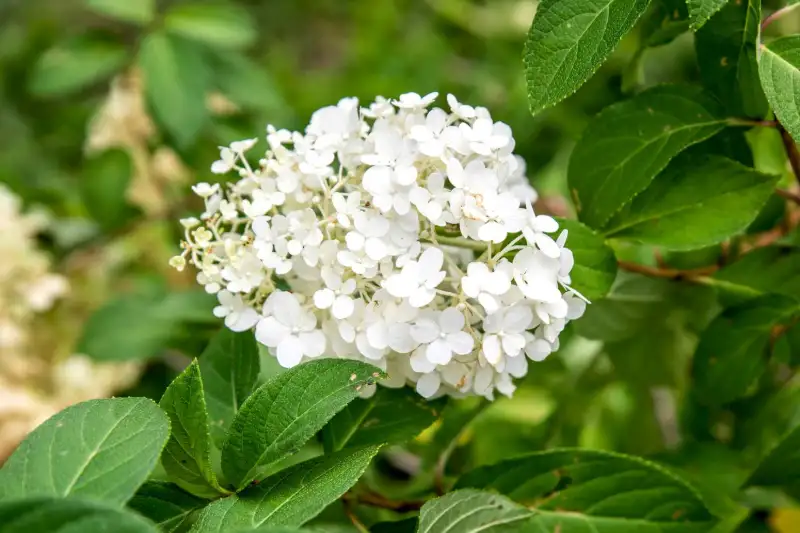
This shrub is a super POPULAR Panicle Hydrangea variety known for white blooms.
Do you know why it differs from other hydrangeas? Because these beautiful shrubs bear gorgeous delicate blooms that pop up mid-summer.
This baby is PART of the Hydrangea paniculata family, having large flowers. It is ORIGINALLY from parts of East Asia, like China and Japan.
The bobo flower is compact and grows about 3 feet tall and wide. They USUALLY have beautiful pink or white flowers.
They START turning into beautiful reddish-pink flowers when autumn arrives. These pink blooms are one of the most beautiful in the hydrangea family.
Bobo likes it sunny, but it can also handle partial shade. It PREFERS well-draining soil but can ADAPT to various soil types, LIKE clay, and sandy dirt.
Plus, they are BEST amongst compact hydrangea varieties in USDA hardiness zones 3-8.
4. Fire Light Tidbit
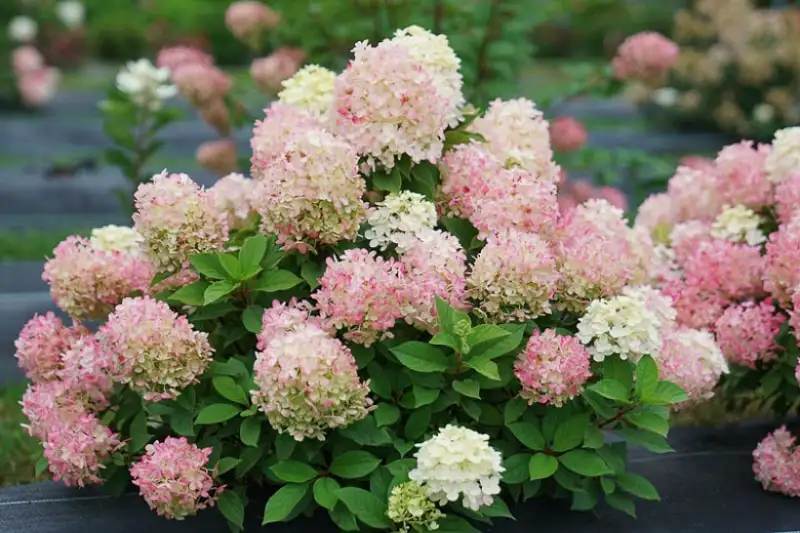
Have you HEARD of Fire Light Tidbit? It’s a gorgeous flower from the hydrangea paniculata family.
Fire Light Tidbit’s flower color is a PURE sight to watch when they turn pink. They can change colors to PINKY-RED, burgundy, or even purple. It DEPENDS on soil pH.
This SMALL plant has an average size of 3 feet tall and 4 feet wide. So it’s GREAT for small-space gardens (to ADD vibrant pop of flower color).
I find Fire Light Tidbit EASY to take care of. Through trial and error, I discovered they LOVE well-drained soil with ample organic matter.
This plant grows well in full sun but can handle afternoon shade. It thrives in USDA growing zones 3-8.
· Hydrangea Macrophylla
5. Paris Rapa

Paris Rapa Flower, or Paris Daisy, is a cool flower native to South Africa.
Their AMAZING flower color comes in pink, purple, and white SHADES. However, they are best KNOWN for white blooms. Don’t forget the beautiful and delicate petals.
I PLANT this Hydrangea Macrophylla each summer; they can grow about 6-12 inches tall. I SUGGEST providing them with full sun and well-drained soil.
This bigleaf hydrangea variety grows well in USDA zones 9-11. If you live outside these zones, you can still EXPERIMENT around. They are hardy!
6. Mini Penny
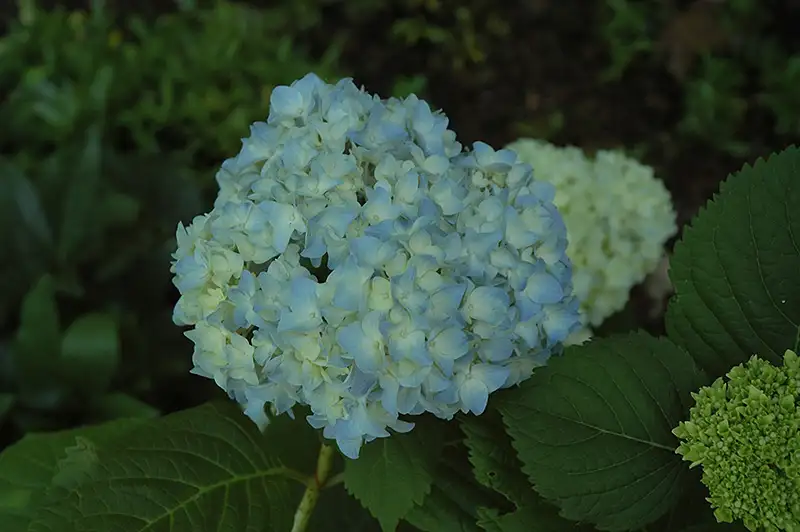
Let me TELL you about these bigleaf hydrangeas called Mini Penny flowers. These Hydrangea Macrophylla are from TROPICAL regions in Asia and Africa.
Mini Penny flowers COME in different SHADES of lime green and burgundy. They can grow up to 2-3 feet tall in USDA zones 9-11.
Plus, they’re DROUGHT TOLERANT and have an awesome TEXTURE. The perfect list of characteristics for hot and dry climates.
Plant Mini Penny in the morning sun or PARTIAL shade. They LIKE well-draining soil for BEST results. Plant them to add VERSATILITY to any garden or landscape.
7. Pistachio
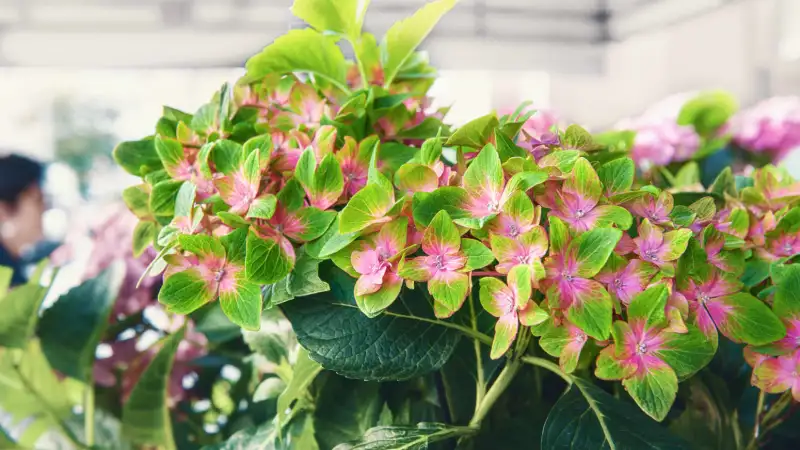
The Pistachio flower or Pistacia vera is NATIVE to the Middle East. Their healing use made them popular in 7,000 BC in Turkey.
These Hydrangea Macrophylla THRIVE in WARMER climates with well-drained soil. Some parts of the Southwestern United States are BEST for their growth.
These blue flowers are best for growing in the USDA growing zone of 7 to 10.
Take my ADVICE and give them a little PRUNE during the SLEEP cycle. It helps their new growth, which you can speed up by tossing fertilizer.
Ensure protection from FROST and wind. This Hydrangea Macrophylla variety is susceptible to these PESKY elements.
8. Monrey
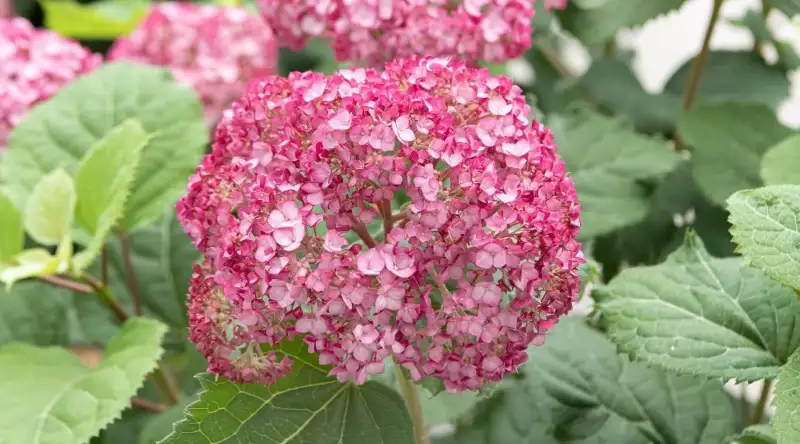
Want to know about another AWESOME Hydrangea Macrophylla VARIETY? Let me introduce you to Monrey Flower or Monarda.
This bigleaf hydrangea is FROM North America! It is best known for its sweet fragrance and abundant blooms.
This hydrangea species has deep pink to light pink flowers. The flower color SHADES vary, including red and purple.
The Monrey Plant likes full sun and well-drained soil. Ensure REGULAR watering to keep the plants HAPPY.
And the best part about these deep pink flowers? It can GROW in a variety of temperatures!
Ensure providing them CARE; these flowers will feel themselves RIGHT at home.
9. Venice Raven
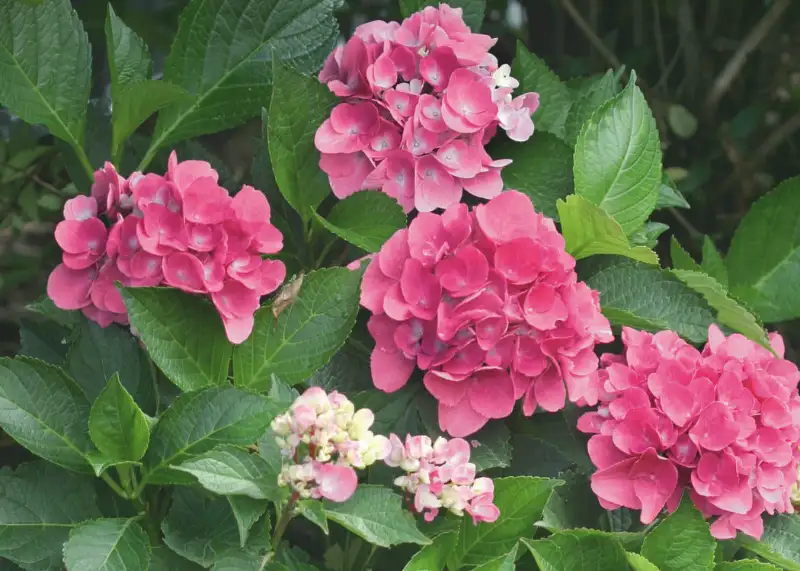
Check out this dope flower called the Venice Raven Flower (aka Salvia Sylvestris). Its flowers are BANGIN’, like dark purplish-blue flowers. They bloom from mid-summer to early fall.
It’s a native plant from the Mediterranean, so it loves that sunny weather. The plant is best GROWN in USDA zones 4-8.
It can grow in VARIOUS soils. But I find DRY soil much better for its growth. The plant loves full sun and needs WATERING on a regular.
When I started growing these babies, I was surprised by how EFFORTLESS is to establish them. Its BEAUTIFUL blooms give you flowers year after year with PROPER care!
· Hydrangea Arborescens
10. Invincibelle Wee White

It’s seriously CUTE and catches your EYE like no other hydrangea plant you’ve ever seen! Those guys are from Asia and North America – talk about an international party!
What’s COOL about these smooth hydrangeas Wee White Flowers? It has LOADS of blooms that stick around for a LONG time.
To ensure this plant is living its best life, give it soil that drains well and put it in some SHADE. Their strong stems are HARDY in USDA zones 3-9, so they are GOOD to go!
Also, this LITTLE fella only gets to be about 1-2 or 3 feet tall and wide. So if you’re living in a TIGHT space, these Invincibelle Wee White Flowers are the WAY to go!
11. Invincibelle Mini Mauvette
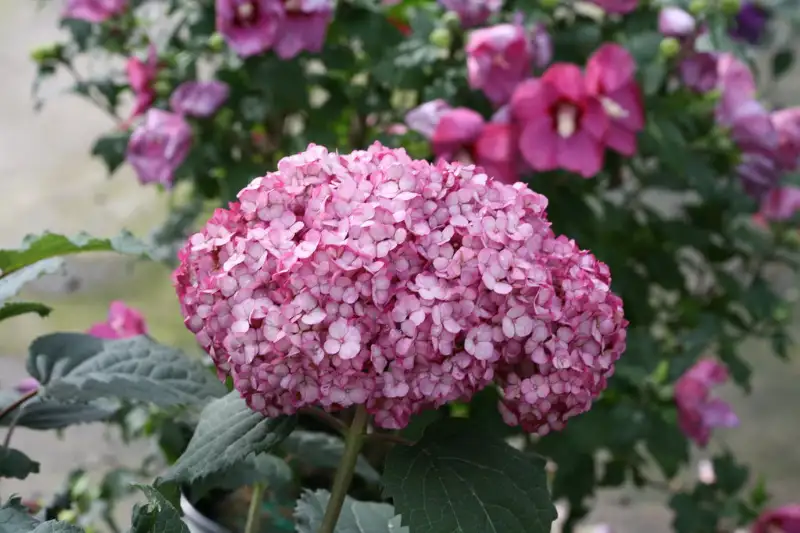
It’s a super pretty flowering plant that belongs to the Hydrangea fam. This BAD BOY is native to North America.
This smooth hydrangea WON’T take over your yard or garden – it only grows about 2-3 feet tall. So, you can PLANT it in small gardens, borders, and EVEN containers!
All it NEEDS to THRIVE is sun, shade, and well-drained soil. No WORRIES. This plant is HARDY and can survive in USDA zones 3-9.
I give it two THUMBS UP for its LONG-LASTING blooms from early summer until fall. Talk about bang for your buck!
I PREFER it over other Hydrangea varieties as it DOESN’T NEED much attention. It’s also RESISTANT to most diseases and pests – SCORE!
· Hydrangea Serrata
12. Tuff Stuff
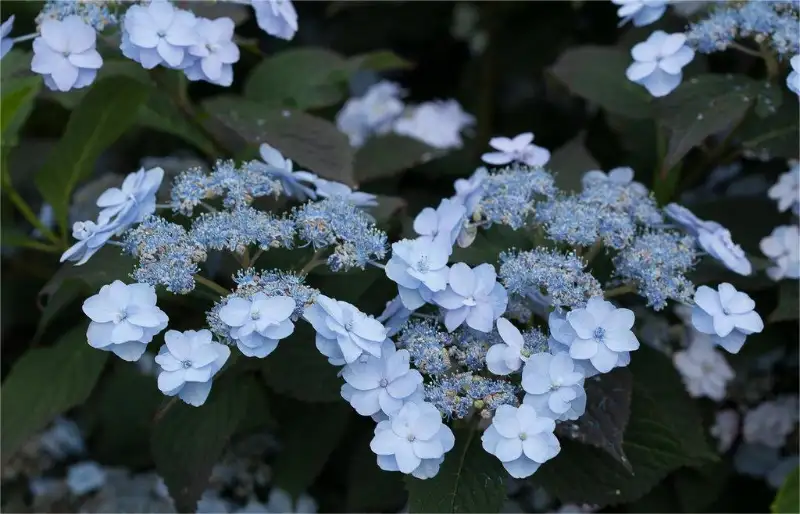
Tuff Stuff flower is an awesome plant species. These blue blooms are native ASIAN continent.
This dwarf version blooms in different colors, sizes, and shades. But Tiny Tuff Stuff Red steals the show with long-duration pink-red flowers.
Taking CARE of this smooth hydrangea is not demanding. It can GROW in USDA growing zones 5-9. It likes a pH range of 4.5-6.0, but you can grow it in slightly alkaline soil.
What’s even COOLER are their evergreen blooms. You can get these beautiful flowers for SEVERAL months in a year.
And get this, it’s pretty tough with little strong stems. THROW them to frost and drought; they will SURVIVE like a champ.
FAQs about Dwarf Hydrangea
1. How big does a dwarf hydrangea get?
The small hydrangea is between 1 and 3 feet tall and wide. This tiny plant bears smaller flowers and has a compact growing habit. The height can vary depending on the variety, care, and environmental factors.
2. Do dwarf hydrangeas like full sun?
The smallest hydrangea likes both worlds. They like partial shade but can survive the full sun. However, exposing them to the sun for extended hours can cause wilt and damage. Ensure their sun requirement according to the variety.
3. Do you cut back dwarf hydrangeas?
Cutting back dwarf hydrangeas is healthy as it promotes growth. Moreover, cutting helps them keep in shape. You can prune them occasionally to remove weak and dead wood.
It’s better to cut back older sturdy stems for new growth. Avoid cutting flower buds as they help reblooming hydrangea plants.
4. How long do dwarf hydrangeas bloom?
The bloom season of dwarf hydrangeas spans early summer to late fall. It depends on the climate, growing conditions, and dwarf hydrangea varieties. You can check the details of each variety to find out their bloom period.
What’s Next
SUMMING UP, Dwarf Hydrangeas are an awesome way to spruce up your garden. They can LAST for ages with proper care.
So, here’s the deal: Make sure you PUT them in soil that drains well and water them often. Trim them back during SPRINGTIME.
Stick with these simple rules and pick the RIGHT kind for your yard. You can BASK in the STUNNING flowers and LEAVES of dwarf hydrangeas all season long.
Get your GARDENING GROOVE on!
Do you want to KNOW the KEY to having an AWESOME garden? Look no further than AsterGardening!
Say GOODBYE to all those pesky plant issues, and prepare to become a gardening PRO! Head on over to OUR website ASAP to get started!
